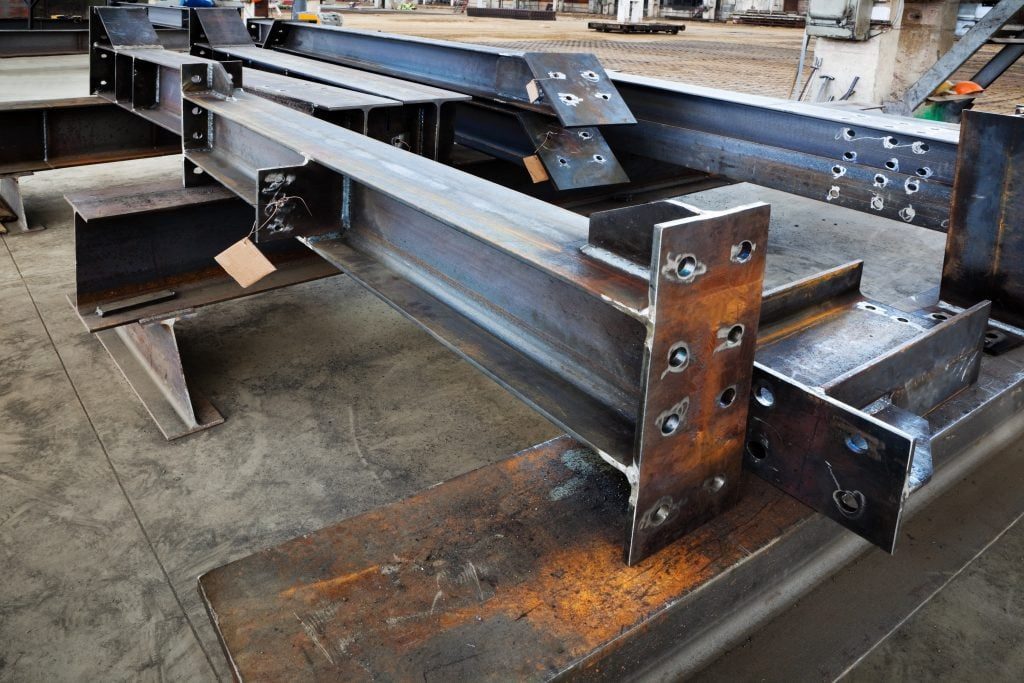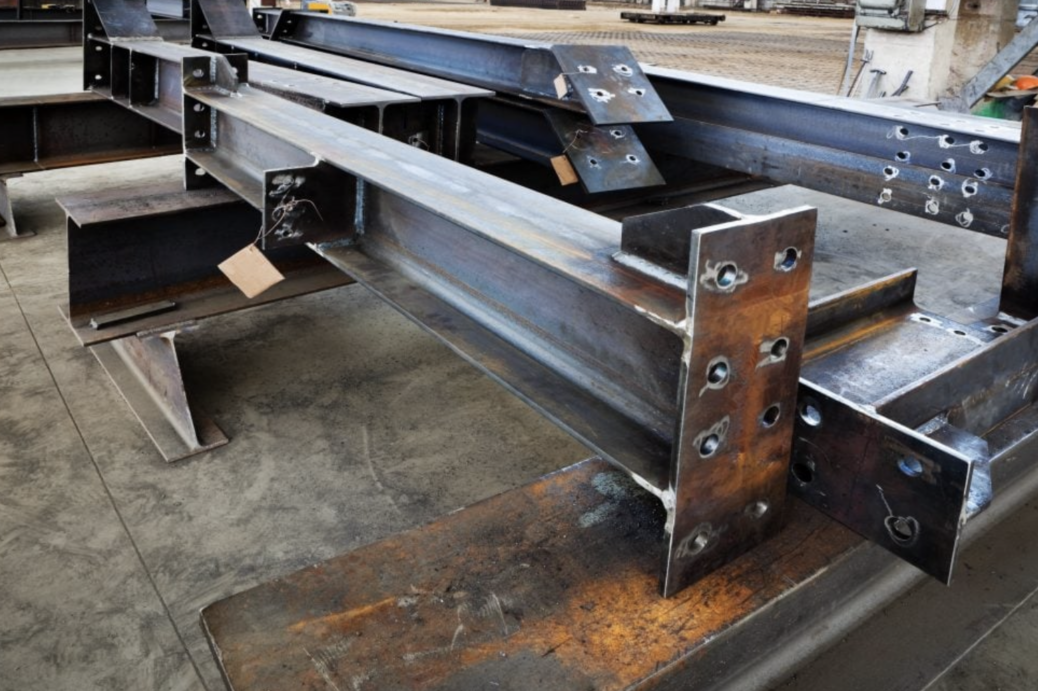
What is structural steel?
Steel, one of the most essential materials of the modern world, comes in various different grades and shapes. It is simply an alloy of iron and a very low amount of carbon (up to 2.1% in weight). The versatile nature of this material enables designers and engineers to use steel in many different kinds of areas. From the automotive industry to the construction of structures, steel is widely used. Structural steel is a type of steel that is used as a construction material. They are designed to have a good strength/weight ratio (which is also called specific strength) and to be cost-effective in order to be benefited as a structural component in buildings, roads, bridges, etc.
A brief history…
The very first introduction of a metal as a structural material was done in England, Shropshire in 1779. Construction of Coalbrookdale Arch Bridge over River Severn was done by using cast iron (having a carbon content higher than 2.1%).
It was a material considered four times stronger than stone and thirty times stronger than wood (1). This kind of cast-iron structure has been continuously constructed in the following years until the 1840s when malleable wrought iron (carbon content less than 0.15%) began to replace heavy cast iron. After that, different grades of steel with more suitable and superior properties for structural applications have been continuously developed until today. Technological advancements such as the development of the Bessemer process and such made steel production easier and more profitable (2). Therefore, the usage of structural steel led to huge developments in architecture and civil engineering in the past century.
Types and grades
There is not just one type of structural steel. There exist various different shapes and grades, depending on the needs for that specific application. Structural steels are classified by the shape of their cross-sections, such as the most frequently used I, T, C shapes (2). Besides their shape, the grade of steel directly affects mechanical properties. So, different grades of structural steel must be chosen according to different design requirements.
Several types of steel can be shaped and used as a beam, rod, plate, bar, or profile. Here are the standard structural steel materials:
Carbon Steels:
Steel can be defined as carbon steel when the addition of any other alloying element (such as tungsten, zirconium, cobalt, nickel, etc.) is not required, copper content does not exceed 0.4% or the following elements does not exceed indicated percentages in weight (Mn: 1.6%, Si: 0.6%, Cu: 0.6%) (3). Carbon steels are generally categorized by their carbon content as low-carbon (< 0.3%), medium-carbon (0.3-0.6%), high carbon (0.6-1%) and ultrahigh carbon (1.25-2%) steels. It is mostly used in structural pipe and tubing.
High Strength Low Alloy Steels:
This kind of steels are designed to have better mechanical properties and be more resistant against atmospheric corrosion than carbon steels. They contain manganese up to 2.0%. Small portions of other alloying elements such as chromium, nickel, molybdenum, nitrogen, vanadium, niobium, and titanium can be used in different combinations to alter the properties (3). Weathering steels which are a sub-type of high strength low alloy steels have high resistance against atmospheric corrosion by forming a passive, rust-like layer on the surface, being one of the important structural steels. Mostly used in structural shapes and plates.
Forged Steels:
Forging is simply the process of shaping the metal while it is in the solid state. It is done by applying mechanical and thermal energy to steel ingots or billets. This process introduces a uniform grain structure to the material, which decreases discontinuity in the matrix by removing voids, gas bubbles and increases overall strength (4).
Quenched and Tempered Alloy Steels:
A type of structural steel (for example A514) mostly used in building constructions. As can be understood from its name, this type of steel has undergone quenching and tempering heat treatment steps.
Why use steel as a structural material? What are the advantages?
Higher strength/weight ratio:
When compared, steel dominates every other conventional structural material such as stone, cement, or wood in terms of strength/weight ratio. It means that the tolerance against poor foundations is higher.
Good ductility:
Ductility is the ability of the material to withstand loads without failure. Thanks to the elastic nature of steel, it can return to its original shape after bending. Yielding up to some point prevents premature failures. Hard and brittle materials can fail suddenly, thus are not favorable.
High Toughness:
The ability of a material to absorb energy is called toughness. Structural steels have high toughness values; thus they are very suitable for construction applications. They are both strong and ductile. Also, it should be mentioned that the main difference between mild and structural steel is that structural steels are stiffer in order to carry higher loads without needless sagging.
Architectural variety:
Steel structures make so various different architectural designs possible. All around the world, astonishing steel buildings, towers, and bridges can be witnessed. One would be surprised to find out that this material was not economically reasonable to use as a structural component, just one hundred years ago.
Saving space:
In a comparison with reinforced concrete, a 40×40 cm2 steel carrier can do the same job as a 100×100 cm2 reinforced concrete carrier. This example shows that a net saving in terms of a usable area can be done (5).
There exist some drawbacks which can be solved with additional costs like corrosion and fire susceptibility, or the risk of buckling under heavy loads. Yet, major advantages may still outweigh these drawbacks in particular design applications.
How is it made?
Steelmaking is a rather long and complicated process to explain all in detail. So, for now, we will exclude all the initial steps of the process. After hot steel is produced, it can be cast either directly into the desired shape or as slab. Slabs can be formed into different shapes by cold working or forging. Heat treatment can be also done, depending on the application. After fabrication, chemical and mechanical tests should be performed according to standards. Without proper quality testing, catastrophic accidents may occur due to flaws in the material.
How to choose your manufacturer?
It can be troubling to decide on a such important matter. A wrong decision in the manufacturer can be costly. Our advice given below can be useful when choosing your manufacturer (6) (7).
Know what you are looking for.
Determine your priorities and expectations from your manufacturer before the interview with the candidates.
Take your time.
There is no point in rushing into a relationship with a manufacturer. Test multiple companies if necessary and choose the best one for you.
Ask for the background.
A company with a good history is less likely to let you down, best to keep that in mind.
Think at the margin.
Things may not go so bright for you all the time. On the days like these, the number of your orders would fall. Therefore, it is important to negotiate and come to terms on defining minimums of order before establishing a collaboration.
(1) M.H. Sawyer. World’s First Iron Bridge. Civil Engineering (New York: ASCE, December, 1979) pp.46-49
(2) McCormac, J. C. (1971). Structural steel design. Intext Educational Publishers.
(3) “Classification of Carbon and Low Alloy Steels” Retrieved in 15-07-2019 from https://www.totalmateria.com/page.aspx?ID=CheckArticle&LN=TR&site=kts&NM=62
(4) “How does forging strengthen metal?” Retrieved in 15-07-2019 from http://www.dropforging.net/how-does-forging-strengthen-metal.html
(5) ”What is structural steel?” Retrieved in 16-07-2019 from
https://apec.com.tr/en/what-is-structural-steel/
(6) “How to find the right manufacturer for your products?” Retrieved in 16-07-2019 from
https://www.sourcify.com/how-to-find-the-right-manufacturer-for-your-products/
(7) ”How to find a factory to manufacture your product?” Retrieved in 16-07-2019 from
https://www.businessnewsdaily.com/8820-how-to-find-factory.html
You May Be Interested
- https://yenaengineering.nl/structural-steel-production-and-todays-building-market/
- https://yenaengineering.nl/causes-structural-steel-is-correct-for-structure-building/
- https://yenaengineering.nl/6-essential-questions-worth-asking-to-your-structural-steel-provider/
- https://yenaengineering.nl/footbridges-manufacturing-by-using-structural-steel/
- https://yenaengineering.nl/a-comprehensive-guide-to-structural-steel-2/


